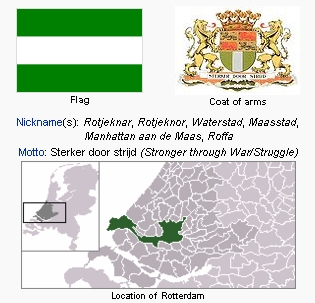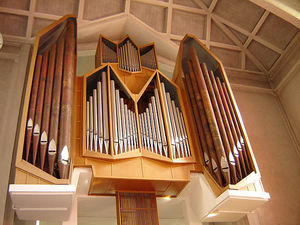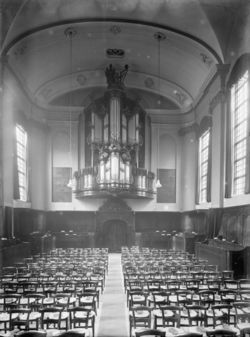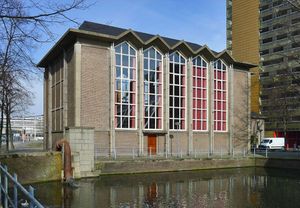Difference between revisions of "Rotterdam (Zuid-Holland, Netherlands)"
| [checked revision] | [checked revision] |
m (Text replace - "Scheffer, Hoop and Jacob Gijsbert de." to "Hoop Scheffer, Jacob Gijsbert de.") |
m (Text replace - "<em>Mennonitisches Lexikon</em>, 4 vols. Frankfurt & Weierhof: Hege; Karlsruhe: Schneider, 1913-1967: v. III," to "''Mennonitisches Lexikon'', 4 vols. Frankfurt & Weierhof: Hege; Karlsruhe: Schneider, 1913-1967: v. III,") |
||
| Line 58: | Line 58: | ||
Hazewinkel, H. C. <em>Geschiedenis</em> <em>van Rotterdam. </em>Amsterdam, 1940: I, 159-63; II, 214 f. | Hazewinkel, H. C. <em>Geschiedenis</em> <em>van Rotterdam. </em>Amsterdam, 1940: I, 159-63; II, 214 f. | ||
| − | Hege, Christian and Christian Neff. | + | Hege, Christian and Christian Neff. ''Mennonitisches Lexikon'', 4 vols. Frankfurt & Weierhof: Hege; Karlsruhe: Schneider, 1913-1967: v. III, 554-58. |
Mellink, Albert F.<em> De Wederdopers in de noordelijke Nederlanden 1531-1544</em>. Groningen: J.B. Wolters, 1954: 222-26. | Mellink, Albert F.<em> De Wederdopers in de noordelijke Nederlanden 1531-1544</em>. Groningen: J.B. Wolters, 1954: 222-26. | ||
Latest revision as of 00:58, 16 January 2017


Source: http://www.orgelsite.nl/kerken47/rotterdam-doopsgezkerk.htm.

Photo by J. P. A. Antonietti, Rijksdienst voor het Cultureel Erfgoed.
Source: Wikimedia Commons.
Rotterdam, a city (1958 population, 720,000, with some 1,750 Mennonites; 584,406 in 2007) of the Dutch province of South Holland (coordinates: 51° 55′ 18″ N, 4° 28′ 52″ E). The fact that two Anabaptist martyrs, Anneken Jans and Christina Michiels Barents, were drowned here on 24 January 1539, does not prove the existence of a congregation here at that early date, for both women were merely passing through the city when arrested.
Nevertheless there was some Anabaptist activity here in 1534, led by Jan Jansz Schot, and an Anabaptist congregation was doubtless established at Rotterdam soon after 1540, which conducted itself quietly. Since the government here was more tolerant than, for example, in Amsterdam or Antwerp, or perhaps because there were fewer Anabaptists living here than at some other places, there were relatively few martyrs at Rotterdam—a total of about 24 in 1534-68, besides a number who were expelled from the city. One of the anonymous martyrs of 1544 was a girl of fourteen, who left a song. In 1558, at the scene of an Anabaptist execution, when the executioner was clumsily strangling Jan Hendricks preliminary to burning him, the crowd released the other four prisoners. Concerning the death of Hendrik Arentsz in 1568, van Braght's Martyrs' Mirror gives a full account. Little is known of the congregation in the early period. In 1556 it met in a home in Houttuyn. Leenaerdt Bouwens visited it repeatedly, baptizing 15 persons here in 1554-56, 7 (or 15) in 1557-61, and at least 100 in 1563-75. Soon thereafter there was an influx of persecuted Anabaptists fleeing from Flanders, Belgium.
In the last three decades of the 16th century the Rotterdam congregation, like most of the Dutch congregations, was divided by doctrinal dissension. About 1590 there were at least five congregations here: Flemish, Old Flemish, Waterlander, Frisian, and High German. By 1620 the Waterlanders, Frisians, and High Germans had united; but there was still a splinter of the High German group, perhaps identical with the Claes Woutersz group, and in addition a congregation of Flemish and one of Old Flemish, both in existence since 1590. It is hardly possible to form an actual picture of the various mergers and divisions in the 17th century before 1671. In that year there were three congregations: (a) Old Flemish, (b) Flemish, also called Flemish and High German, with which the conservative Frisians had united, and (c) Waterlander, to which the progressive (Young) Frisians and Mild Flemish belonged.
The (a) Old Flemish were extremely conservative; they co-operated with the group known as the Danzig Old Flemish, an association of Mennonite congregations, which included seven small congregations in the Netherlands and some conservative congregations in West Prussia. This Rotterdam congregation was always small, usually 20-30 members, and met in a home called Het Arkje, behind die Lombardstraat. By 1740 its pulpit was vacant and by 1770 the congregation was extinct.
The (b) Flemish congregation met in a meetinghouse behind Leeuwenstraat from 1609. The meetinghouse was enlarged in 1645. In 1650 the membership was some 200. This group had important elders in the 17th century. One of these was Bastiaan van Weenighem 1659-86, who often visited other Mennonite congregations, for example, Hamburg-Altona in 1661. He was followed by Herman Schijn, who moved to Amsterdam in 1690. In 1656 a call was given to the influential Dordrecht elder Tieleman Jansz van Braght, but he declined. This Rotterdam congregation was a sort of mother church to a number of small Flemish congregations in the vicinity, giving repeated financial aid and free ministerial service to those at Brielle, Delft, Geervliet, Gouda, Middelharnis, Oosterhout, Schoonhoven, Spijkenisse, Zevenhoven, and Zuidland, all of which nonetheless died out around the turn of the century. In 1632 the deacons Balten Centen Schoenmaker and Michiel Michielsz signed the Dordrecht Confession for the Flemish congregation.
In 1652 and the following years the Rotterdam Flemish congregation was threatened by a serious division because a number of its members were Collegiants; in 1655 order was restored when five preachers were expelled with their following. The congregation was now very conservative (no contact with Collegiants, close communion, strict church discipline). In 1664 it joined the Zonists. Gradually the conservatism relaxed; in 1675 religious instruction for children was introduced, which had previously been given by the parents. In 1682 the Biestkens Bible was replaced by the state translation (Statenvertaling). A union with the Waterlanders was in prospect.
The (c) Waterlander congregation, which was represented in 1579 at a Waterlander conference at Emden and at Amsterdam in 1581. It was far less important than the Flemish in numbers, wealth, and influence, held its meetings at the Quakernaat (probably from 1592, at any rate from before 1620). It was less conservative in the use of the ban, mixed marriages, and the admission of members of other creeds (other Mennonite branches, Remonstrants and Reformed) to communion. Dissatisfied Flemish transferred their membership to the Waterlanders; in 1592-1620 an entire Frisian congregation made the transfer. The influx of the Flemish contributed to the involvement of the Waterlanders in the Collegiant dispute; the congregation was divided into two parties in 1655-72, one in favor of and one opposed to the Collegiants.
In 1647 and again in 1655 an attempt was made to unite the Waterlanders with the Flemish; but the offers were rejected by the Flemish. Twice there was talk of merger with the Remonstrants; in 1658 the Remonstrants seem to have taken the initiative, and in 1669-70 the Waterlanders led; both attempts failed. Since 1664 the congregation had belonged to the Lamists. In the conference meetings of the Lamist or South Holland Sociëteit Jan van Ranst, a Rotterdam preacher, began in 1676 to urge the establishment of a theological seminary. The Waterlander congregation had begun religious instruction (1672) three years earlier than its sister church. A member was appointed to visit the sick, and in 1687 the first salaried preacher, Hendrik Toren, a baker, was engaged. In October 1696 negotiations were inaugurated leading to a merger with the Flemish congregation. This merger became reality in 1700. The old partisan names that had caused so much damage, were buried; the congregation was now called the United Mennonite Church. Abraham van Loon, of Gouda, preached the sermon of unification on 6 June 1700.
Both meetinghouses were used until 1776, when the Waterlander "preaching house" at the Quakernaat was sold. The congregation had built a stately church with room for all on the site of the Flemish meetinghouse on Leeuwenstraat. This building was made possible by the legacy of the brothers Pieter and Jan Bisschop, wealthy yarn merchants, the latter of whom died in 1771 at the age of 91. The dedicatory sermon for the church, a fine specimen of baroque architecture and furnished with an organ, was preached by the pastor, Jacob Ouwejans.
In spite of the unification and the agreement to forget the ancient quarrels, tensions remained throughout the 18th century between a group of Flemish origin and a group of the more liberal Waterlanders. Especially after Ouwejans' death, who had served from 1742 to 1781 and given it a conservative stamp, the old strife threatened to flare up again, but was permanently settled in 1786 with the choice of the pacific Wytse Sytses Hoekstra as pastor.
In 1700 at the time of the merger there were 400 members—143 men and 257 women. In the 18th century certain names recurred: Dekker, van Gilse, Jansen, de Koker, Lommen van Lil, Messch(a)ert, van der Pals, van Rijkevorsel, van Rijnbach, van Sleiden, Staal, Verloove, van Vollenhoven, Wynands. In the 19th century the following names were added: Altmann, Cupedo, Dutilh, Gerpot, Hulshoff, de Monchy, Rueb, and Sieuwertsz van Reesema. Most of these old families have died out or moved away; only Altmann, de Monchy, Rueb, Staal, and Verloove remain.
Jacob Ouwejans served as pastor 1742-died 81, Jan Menalda 1771-died 1800, Keimpe Dam 1773-died 1810, Wytze Sytses Hoekstra 1786-died 1801, Nicolaas Messchaert 1802-33 (he died of cholera), Abraham Jacobus van Pesch 1834-41, Pieter van der Goot 1842-51, Sytse Hoekstra Bz, who later taught in the Seminary at Amsterdam, 1852-57, J. P. Müller 1857-62, Jacobus Craandijk 1862-84, Johannes Dyserinck 1884-1901. Under Craandijk and particularly Dyserinck Modernism found its way into the congregation, without, however, causing any difficulties or dissension. Since 1902 the preachers have been A. Binnerts Szn 1902-7, F. Dijkema 1907-16, S. H. N. Gorter 1916-46, Miss D. Groeneveld 1924-28, Miss S. Goossen 1928-34, Mrs. H. C. Voorhoeve-ten Bruggencate 1936-48, N. van der Zijpp 1946- , and D. E. W. Siccama 1950-.
The Mennonites of Rotterdam have always been on good terms with the city government. Only occasionally, during the 17th century, some obstacles were placed on their path. Permission to enlarge the meetinghouses was always willingly granted. In 1629 the Waterlander preacher Edward Nabels was excused from assuming the office of sheriff, which he rejected for reasons of nonresistance, upon payment of a "gift" of 25 guilders for the Reformed poor (Hoop Scheffer, Jacob Gijsbert de. Inventaris der Archiefstukken berustende bij de Vereenigde Doopsgezinde Gemeente to Amsterdam, 2 vols. Amsterdam: Uitgegeven en ten geschenke aangeboden door den Kerkeraad dier Gemeente, 1883-1884: I, No. 447). A good testimonial is given the Rotterdam Mennonites in a letter written on 19 February 1660, by the magistrate of Rotterdam to the city of Bern, Switzerland, in behalf of the suppressed Bernese Anabaptists (Hoop Scheffer, Jacob Gijsbert de. Inventaris der Archiefstukken berustende bij de Vereenigde Doopsgezinde Gemeente to Amsterdam, 2 vols. Amsterdam: Uitgegeven en ten geschenke aangeboden door den Kerkeraad dier Gemeente, 1883-1884: I, No. 1746). Once or twice the burgomasters made serious difficulties: in 1693 the deacons and preachers of the Waterlander congregation were summoned to court on a charge of Socinianism. In 1718 Pastor David van Heyst was called before the burgomasters of Rotterdam on a charge of unorthodoxy. On both these occasions an oral confession of faith was sufficient. The matter was cleared by a visit of a committee of the church council to the burgomasters. In 1795, when military conscription became law, it took some effort to establish the release of the Mennonites from armed duty; the beautiful new church was used for political meetings and even for military drill. At that time, as everywhere in the Netherlands after 1796, the Mennonites took part in the city government. The Mennonites have had an active part in the economic rise of Rotterdam; especially the van Vollenhoven and de Monchy families are engaged in trade and shipping.
On two occasions the Rotterdam congregation, which had previously been very active in supporting oppressed Mennonites elsewhere, as in 1660 and 1710 those in Switzerland, in 1690 those in the Palatinate, and after 1730 those in Prussia, was of particular importance for Mennonitism in other countries. In the first half of the 18th century, especially in 1709-34, many Mennonite emigrants from Switzerland and the Palatinate went to America by way of Rotterdam. They were generally cared for by the church board, and sometimes even clothed, and considerable sums were used by the congregation to transport them to London, the port of exit for Pennsylvania. Some were helped to sail directly from Rotterdam to America. In 1709 the preacher Hendrik Toren and the deacon Jan van Gent are said to have promoted the transportation to England of the Palatine Mennonites who had come to Rotterdam; over 1,000 of them, however, were persuaded by Toren and van Gent to return to the Palatinate. In 1735, 180 Mennonite emigrants were shipped to Pennsylvania by Archibald and Isaac Hope, members of the Rotterdam Mennonite congregation, and again 3,000 in 1753 and 4,000 in 1765 (most of the last two groups were Lutherans), all from the Palatinate. The second time when Mennonites, expelled from their homes, traveled to the New World via Rotterdam began in 1924, when the Dutch Mennonite Emigrant Bureau was established for the benefit of the Russian Mennonite refugees. Led by S. H. N. Gorter, J. Th. de Monchy, C. S. Altmann, and J. N. de Jong, the Bureau did an extensive work. Over 1,000 of these Mennonites left Europe for Canada and Brazil via Rotterdam in 1924-31. On 27 January 1947, the Volendam sailed from Rotterdam with 442 Russian Mennonites, and after stopping at Bremerhaven to pick up 1,863 more refugees, went on to Paraguay.
World War II brought unspeakable distress to Rotterdam—occupation, bombs, destruction, hunger, and death. The Mennonite congregation was also hard hit. In consequence of losses through bombing, hunger, compulsory resettlement of elderly persons in the country and of younger persons into foreign lands, the membership dropped from 1,252 to 835. A great misfortune struck the congregation in the early days of the war, on 14 May 1940, when with the heart of the city their beautiful church was burned down. Little was saved. A valuable collection of portraits was lost along with the silver baptismal plate (six costly silver communion cups acquired in 1780 and two antique pewter wine jars from the 17th century were saved); some of the archives, however, were saved, for they had temporarily been stored elsewhere. During the war and occupation, congregational life was carried on as well as possible. Services were held at various places with many changes. Plans were made before the war was over for the rebuilding of the church, but it took some years after its close before the plans of the young architect Gerrit Kuiper, a member of the congregation, could become reality. On 27 October 1950, the moderator H. G. J. de Monchy started the machine that drove the first concrete pillar into the ground. On 21 December 1951, the new church, with its spacious side buildings, could be used. Both pastors preached on the occasion. The building was made possible only by the sacrificial giving of the entire congregation and the generous support of the entire Dutch Mennonite brotherhood. The fine pipe organ, acquired in 1957, was largely a munificent gift by one of the members.
The congregation is led by a church council, which consists of the ministers and twelve members who are chosen for five-year terms. Until 1921 the church board was self-perpetuating; the trustees are now elected by the congregation. The church council is assisted by the Oude dienst, that is, a committee of retired deacons. Since 1952 there has also been a committee of twelve lay members, which cares for the financial and social needs of the congregation, the fund for this work being provided by the church council. The church has a choir, four women's groups, a youth circle (ages 18-35), a section of Menniste Bouwers (ages 12-18), a West Hill Sunday school (ages 4-12), and a study group of the Peace Group.
Bibliography
Bezemer, W. "Geloofsvervolgingen te Rotterdam 1534-39," in Archief Nederland Kerkgeschiedenis VI. (1897): 52 ff.
Braght, Thieleman J. van. Het Bloedigh Tooneel of Martelaers Spiegel der Doops-gesinde of Weereloose Christenen, Die om 't getuygenis van Jesus haren Salighmaker geleden hebben ende gedood zijn van Christi tijd of tot desen tijd toe. Den Tweeden Druk. Amsterdam: Hieronymus Sweerts, 1685. Part II. 70 f., 143-45, 191-96, 383.
Braght, Thieleman J. van. The Bloody Theatre or Martyrs' Mirror of the Defenseless Christians Who Baptized Only upon Confession of Faith and Who Suffered and Died for the Testimony of Jesus Their Saviour . . . to the Year A.D. 1660. Scottdale, PA: Herald Press, 1951: 472 f., 453 f., 574-78, 736. Available online at: http://www.homecomers.org/mirror/index.htm.
Cate, Steven Blaupot ten. Geschiedenis der Doopsgezinden in Holland, Zeeland, Utrecht en Gelderland, 2 vols. Amsterdam: P.N. van Kampen, 1847: v. I and II.
Doopsgezinde Bijdragen(1861): 171 f.; (1862,): 110 f.; (1864): 102-23; (1869): 120-24; (1872): 57; (1877): 86; (1892): 103, 117-27; (1896): 55; (1897): 78-82, 97 ff.; (1900): 94; (1905): 169-75; (1906): 141-45; (1908): 89-104; (1917): 122, No. 159, 152; (1918): 49.
Doopsgezind Jaarboekje (1953): 34-37.
Goner, S. H. N. "Destruction and Reconstruction of Mennonite Churches in Holland." Mennonite Life I January (1946): 31.
Hazewinkel, H. C. Geschiedenis van Rotterdam. Amsterdam, 1940: I, 159-63; II, 214 f.
Hege, Christian and Christian Neff. Mennonitisches Lexikon, 4 vols. Frankfurt & Weierhof: Hege; Karlsruhe: Schneider, 1913-1967: v. III, 554-58.
Mellink, Albert F. De Wederdopers in de noordelijke Nederlanden 1531-1544. Groningen: J.B. Wolters, 1954: 222-26.
Hoop Scheffer, Jacob Gijsbert de. Inventaris der Archiefstukken berustende bij de Vereenigde Doopsgezinde Gemeente to Amsterdam, 2 vols. Amsterdam: Uitgegeven en ten geschenke aangeboden door den Kerkeraad dier Gemeente, 1883-1884: v. I, Nos. 143, 207, 216, 384-89, 393 f, 447, 613, 778, 781, 784, 801, 804, 806 f., 815, 835, 885, 907, 1060, 1064, 1066, 1133, 1188, 1248, 1543, 1746, 1788, 2248, 2251 f., 2256, 2258 f., 2264 f., 2268, 2274-79. v. II, Nos. 2123-41, 2194-2213, 2242, 2477, 2479, 2955, 3304, 3313.
Verheul J. Dzn. De Doopsgezinde Gemeente en haar Kerhgebouw te Rotterdam. Rotterdam, 1907.
Vos, K. Geschiedenis der Doopsgezinde gemeente te Rotterdam. Rotterdam, 1907.
Additional Information
Congregation: Doopsgezinde Gemeente Rotterdam
Address: Noordmolenwerf 1-3, 3011 AK Rotterdam, Netherlands
Telephone: 010-4124856
Church website: Doopsgezinde Gemeente Rotterdam
Denominational affiliation:
Algemene Doopsgezinde Sociëteit
Doopsgezinde Gemeente Rotterdam Membership
| Year | Members |
|---|---|
| 1700 | 400 |
| 1771 | 250 |
| 1808 | 102 |
| 1847 | 195 |
| 1861 | 234 |
| 1900 | 498 |
| 1918 | 1,031 |
| 1940 | 1,252 |
| 1945 | 835 |
| 1958 | 990 |
Maps
| Author(s) | Nanne van der Zijpp |
|---|---|
| Date Published | 1959 |
Cite This Article
MLA style
Zijpp, Nanne van der. "Rotterdam (Zuid-Holland, Netherlands)." Global Anabaptist Mennonite Encyclopedia Online. 1959. Web. 27 Nov 2024. https://gameo.org/index.php?title=Rotterdam_(Zuid-Holland,_Netherlands)&oldid=146197.
APA style
Zijpp, Nanne van der. (1959). Rotterdam (Zuid-Holland, Netherlands). Global Anabaptist Mennonite Encyclopedia Online. Retrieved 27 November 2024, from https://gameo.org/index.php?title=Rotterdam_(Zuid-Holland,_Netherlands)&oldid=146197.
Adapted by permission of Herald Press, Harrisonburg, Virginia, from Mennonite Encyclopedia, Vol. 4, pp. 371-374, 1148. All rights reserved.
©1996-2024 by the Global Anabaptist Mennonite Encyclopedia Online. All rights reserved.

